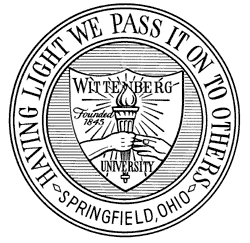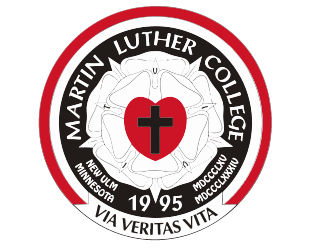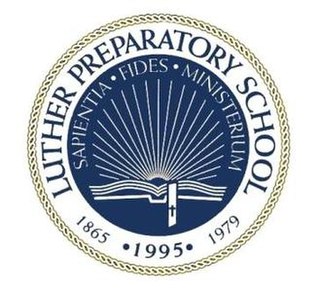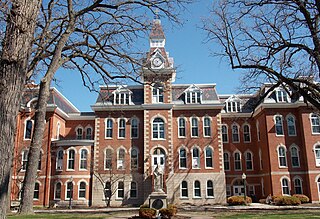
Wittenberg University is a private liberal arts college in Springfield, Ohio. It has 1,326 full-time students representing 33 states and 9 foreign countries. Wittenberg University is associated with the Evangelical Lutheran Church in America.

Mequon is the largest city in Ozaukee County, in the U.S. state of Wisconsin, and the third-largest city in Wisconsin by land area. Located on Lake Michigan's western shore with significant commercial developments along Interstate 43, the community is a suburb in the Milwaukee metropolitan area. Despite being an incorporated city, approximately half of Mequon's land is undeveloped and agriculture plays a significant role in the local economy. At the time of the 2010 census the population was 23,132.

The Lutheran Church—Missouri Synod (LCMS), also known as the Missouri Synod, is a traditional, confessional Lutheran denomination in the United States. With 1.8 million members, it is the second-largest Lutheran body in the United States. The LCMS was organized in 1847 at a meeting in Chicago, Illinois, as the German Evangelical Lutheran Synod of Missouri, Ohio, and Other States, a name which partially reflected the geographic locations of the founding congregations.

Augsburg University is a private university in Minneapolis, Minnesota. It is affiliated with the Evangelical Lutheran Church in America. It was founded in 1869 as a Norwegian-American Lutheran seminary known as Augsburg Seminarium. Today, the university enrolls approximately 3,000 undergraduate students and 800 graduate students. The university is known for its emphasis on service learning; volunteering in the community is both an instructional strategy and a required part of a student's coursework.

The Wisconsin Evangelical Lutheran Synod (WELS), also referred to simply as the Wisconsin Synod, is an American Confessional Lutheran denomination of Christianity. Characterized as theologically conservative, it was founded in 1850 in Milwaukee, Wisconsin.

Concordia Seminary is a Lutheran seminary in Clayton, Missouri. The institution's primary mission is to train pastors, deaconesses, missionaries, chaplains, and church leaders for the Lutheran Church–Missouri Synod (LCMS). Founded in 1839, the seminary initially resided in Perry County, Missouri. In 1849, it was moved to St. Louis, and in 1926, the current campus was built.

Union Presbyterian Seminary is a Presbyterian seminary in Richmond, Virginia. It also has a non-residential campus in Charlotte, North Carolina and an online blended learning program.

Concordia University Wisconsin (CUW) is a private Lutheran university in Mequon, Wisconsin. It is part of the seven-member Concordia University System operated by the Lutheran Church–Missouri Synod (LCMS).

Capital University is a private university in Bexley, Ohio. Capital was founded as the Theological Seminary of the Evangelical Lutheran Synod of Ohio in 1830, and later was associated with that synod's successor, the American Lutheran Church. The university has undergraduate and graduate programs, as well as a law school. Capital University is the oldest university in Central Ohio and is one of the oldest and largest Lutheran-affiliated universities in North America.

Martin Luther College (MLC) is a private college in New Ulm, Minnesota, operated by the Wisconsin Evangelical Lutheran Synod (WELS). Martin Luther College was established in 1995, when Northwestern College (NWC) of Watertown, Wisconsin, combined with Dr. Martin Luther College (DMLC) of New Ulm on the latter's campus.

The Evangelical Lutheran Synodical Conference of North America, often known simply as the Synodical Conference, was an association of Lutheran synods that professed a complete adherence to the Lutheran Confessions and doctrinal unity with each other. Founded in 1872, its membership fluctuated as various synods joined and left it. Due to doctrinal disagreements with the Lutheran Church–Missouri Synod (LCMS), the Evangelical Lutheran Synod (ELS) and the Wisconsin Evangelical Lutheran Synod (WELS) left the conference in 1963. It was dissolved in 1967 and the other remaining member, the Synod of Evangelical Lutheran Churches, merged into the LCMS in 1971.

Luther Preparatory School is a residential four-year secondary school located in Watertown, Wisconsin, United States. Established in 1865, it is owned and operated by the Wisconsin Evangelical Lutheran Synod (WELS). LPS focuses on preparing students to become WELS pastors and teachers and to continue their education at Martin Luther College (MLC), a WELS college in New Ulm, Minnesota. Curriculum at LPS focuses on the liberal arts and religious studies.
Horizon College and Seminary is a multi-denominational Evangelical Christian College in Saskatoon, Canada.

Michigan Lutheran Seminary (MLS) is a coeducational, private preparatory school for boarding and day students in grades 9 through 12. Located in Saginaw, Michigan, the school encourages students to become pastors and teachers in the Wisconsin Evangelical Lutheran Synod, continuing their education at Martin Luther College in New Ulm, Minnesota.
Australian Lutheran College (ALC), formerly Luther Seminary and Lutheran Teachers College, is a higher education institution serving the Lutheran Church of Australia and a registered teaching institution of University of Divinity. It is located in North Adelaide, South Australia on the corner of Ward and Jeffcott streets. The campus includes a number of single and shared accommodation blocks, a library, a refectory as well as educational facilities.

The Lutheran Theological Seminary at Philadelphia (LTSP), also known as the Philadelphia Seminary, was one of eight theological seminaries associated with the Evangelical Lutheran Church in America, the largest Lutheran denomination in North America. It is located on Germantown Avenue in the Mount Airy neighborhood of northwestern Philadelphia. Founded in 1864, it has its roots in the Pennsylvania Ministerium established in 1748 in Philadelphia by Henry Melchior Muhlenberg.

Ambrose Hall, located in Davenport, Iowa, United States, is the first building constructed on the campus of St. Ambrose University. It was listed on the National Register of Historic Places in 1977.

Concordia College was an educational institution of the Lutheran Church–Missouri Synod (LCMS) whose main purpose was to prepare men to enter one of the synod's seminaries. It was founded as a German-style gymnasium in Perry County, Missouri, in 1839. It was moved to St. Louis, Missouri, in 1847, and ultimately to Fort Wayne, Indiana, in 1861. In 1935, the high school department of the school was separated from the junior college to form Concordia Lutheran High School. Concordia College was closed in 1957 when the LCMS opened Concordia Senior College on a new campus in Fort Wayne..The former campus was purchased by the Indiana Institute of Technology.
The Lutheran High School of Milwaukee was a Lutheran high school operated by congregations of the Missouri and Wisconsin synods in the Milwaukee, Wisconsin, area from 1903 to 1955. Started in an unused classroom of Immanuel Lutheran School with 18 students, it moved in 1904 to the former site of the Wisconsin Synod's seminary at 13th and Vine streets. Enrollment increased to 340 in 1929 and led to construction of additional buildings at the site. The Great Depression caused enrollment to decline to 265 in 1938, but with the end of the depression, enrollment steadily increased to 848 in 1948. Plans were initiated to build a larger school at a new site, but doctrinal differences between the two synods resulted in the decision for each synod to build its own separate high school and dissolve the joint operation. The Missouri Synod congregations opened Milwaukee Lutheran High School in September 1955, while the Wisconsin Synod congregations used the old campus for their school, Wisconsin Lutheran High School, until their new building opened in September 1959. The enrollment in the final year of joint operation, 1954–1955, was over 1,100. Both of the successor schools consider 1903 to be their founding date.

Immanuel Lutheran College was an educational institution of the Evangelical Lutheran Synodical Conference of North America whose main purpose was to train Black men to be pastors and both men and women to be teachers. It was founded in Concord, North Carolina, in 1903 and relocated to Greensboro, North Carolina, in 1905. The college was closed in 1961 when the Synodical Conference decided that the training of Blacks should be integrated into the educational institutions of the Lutheran Church–Missouri Synod (LCMS), the largest member of the conference. The former campus was purchased by North Carolina A&T State University.
















